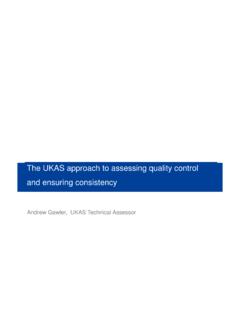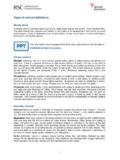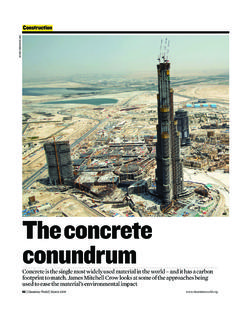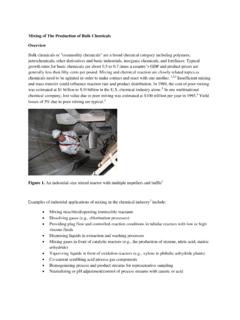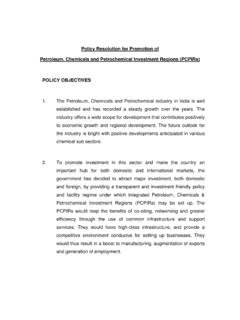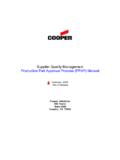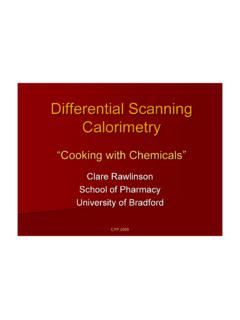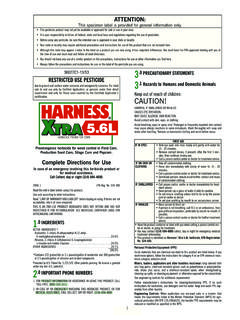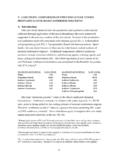Transcription of Mercury, membrane or diaphragm Introduction
1 mercury , membrane or diaphragm Introduction The chloro-alkali industry is a major branch of the chemical industry. Its primary products are chlorine, sodium hydroxide and hydrogen which are produced from rock salt, a readily accessible raw material. This interactive teaching unit is concerned with the different manufacturing processes used to produce these materials. These involve electrochemical cells and, as such, this represents an exercise in applied electrochemistry. Throughout the unit you are required to operate in small groups acting as a design team and are asked to devise the optimum operational arrangement for a particular process.
2 This will require an understanding of the basic electrochemical processes but, in addition, an awareness of economic and environmental issues will also be required. The top 10 chemicals production for the US for 1989 is shown in Table 1. Chlorine and sodium hydroxide were the 8th and 9th largest volume chemicals respectively for that year. Figure 1 shows the chlorine and sodium hydroxide production since 1960 and shows recent output to be roughly constant at ca. 10 million tons. Collectively these data show these materials to be in high demand and that the volumes involved are large. In fact the world-wide manufacturing capacity for each of these chemicals is approximately 40 million tonnes per year chloro-alkali production is big business.
3 Table 1 US top 10 chemicals production (1989) 106 t 1. Sulfuric acid 2. Nitrogen 3. Oxygen 4. Ethylene 5. Ammonia 6. Lime 7. Phosphoric acid 8.
4 Chlorine 9. Sodium hydroxide 10. Propylene TASK 1 Given this large demand for chlorine, sodium hydroxide and hydrogen, what do you think are the market outlets for these bulk chemicals? Form into your sub-groups ( A1, A2, A3, etc.) and together answer the following questions. 1. Describe the principal uses of chlorine, sodium hydroxide and hydrogen. 2. Chlorine is a highly corrosive gas that is difficult to handle. What would be the best way to supply chlorine to the market outlets you have identified in Question 1?
5 024681012141960 1964 1968 1972 1976 1980 1984 1988 Year106 tAnnual ChlorineCapacityCaustic SodaProductionChlorine Production Figure A Unit 2 Class Distrib Section Exercise LT (Whole cla 1. Introduction to class 2. Divide class into sub-groups and move to smaller rooms A B C 3. Introduction to unit A1 A2 A3 B1 B2 B3 C1 C2 4. Background Information 5.)
6 Design teams A1, A2, A3, B1, B2, etc. 6. Design team technical presentations (speaker 1) A1 A2 A3 B1 B2 B3 C1 C2 7. Design team marketing presentations (speaker 2) A B 8. Sub-group discussion. Preparation of summary acetate (speaker 3) 9. Return to LT 10. Plenary session. Sub-group presentation (speaker 3) LT 11. Assessment Unit 2 Timetable Table A Time Section Exercise Duration (mins) 1 Introduction to class.
7 Administration 10 Video 1 5 2 Divide class into sub-groups A, B, C and D and move to smaller rooms 5 3 Introduction to unit Read Task 1 Discuss 5 5 5 4 Background Information (green) Read Tutor Summary Group Discuss 5 5 5 5 Design Teams Task 2 Initial Information Read and Discuss Further Information Read and Discuss Complete Cell Diagrams Discuss 5 + 10 5 + 5 10 6 Design teams technical presentations (speaker 1) 10 7 Design teams discussion.
8 Design teams marketing presentations (speaker 2) 10 10 8 Sub-group discussion Preparation of summary acetate Preferred choice of cell 10 9 Return to lecture theatre 5 10 Plenary session Sub-group presentation Electrochemical cell performance Video 2 Slides Summary 5 5 5 5 10 11 Assessment 5 End BACKGROUND INFORMATION Chlorine consumption is a major indicator of industrial
9 Activity. It is used as a disinfectant, in water treatment and in processing pulp and paper. Large quantities of chlorine are needed for polyvinyl chloride (about 15 million tonnes per year in 1990), an important material in the building industry as well as for consumer goods. Chlorine is not readily transported or stored in quantity. In many processes, its production forms part of an integrated petrochemicals/plastics complex where it is used immediately on production. Sodium hydroxide has wide applications in mineral processing, the pulp/paper industry as well as textile and glass manufacturing. Hydrogen is used as a chemical feedstock or can be integrated with other hydrogen plants.
10 Electrolytically produced hydrogen is very pure and can be compressed to around 200 atmospheres for transportation in cylinders for a variety of uses. Market Outlets for Sodium Hydroxide0510152025303540 OtherPulp PaperNeutralisationAluminaSoapRayonChemi calsPercentage of ProductionMarket Oultets for Chlorine051015202530 OtherPulp PaperInorganicsChloromethanesPropylene OxideSolventsVinylchloridePercentage of Production Industrial processes in the past In 1870, there were two main manufacturing routes to chlorine. The Weldon process (1), involving the oxidation of hydrochloric acid with manganese dioxide, competed with the Deacon process (2) in which hydrochloric acid was oxidised by air over a copper based catalyst.
